Table of Contents
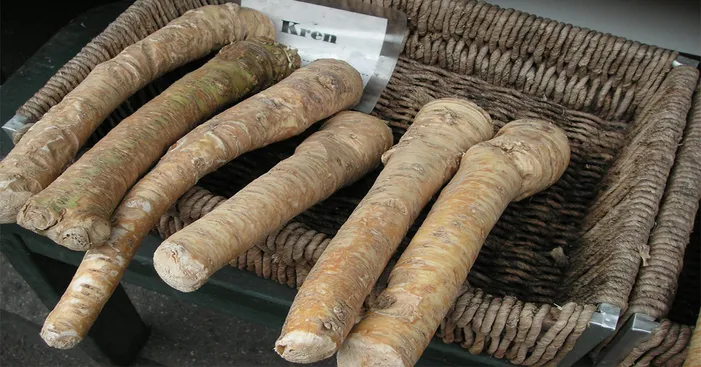
Horseradish is a root vegetable that has been used for centuries as a condiment and medicine.
It has a pungent flavor and aroma that can add a kick to any dish.
Whether you’re a fan of spicy food or just looking to try something new, horseradish is definitely worth exploring.
In this blog post, we’ll take a closer look at this versatile vegetable and explore some of its many uses.
General facts about horseradish root:
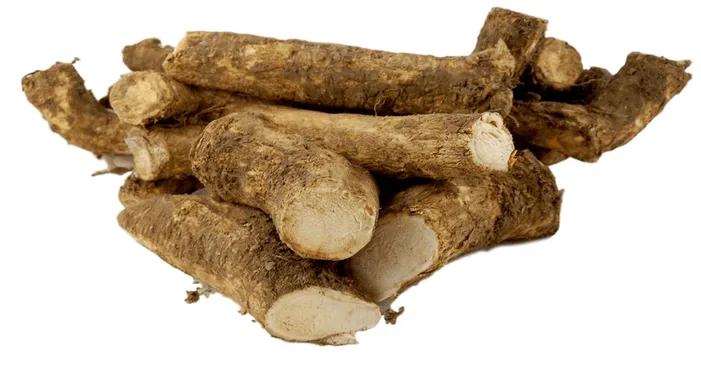
Horse radish overview:
Horseradish belongs to the cabbage family and is a perennial plant native to the Mediterranean basin.
It is cultivated throughout Europe and its health benefits have long been recognized.
The traditions surrounding horseradish have been passed down from generation to generation.
Horseradish is also appreciated in other countries, such as Greece where it is used in many dishes, or in England where it is considered a medicinal plant.
It is also an essential condiment that has conquered the palate with its flavor.
Horseradish stimulates the appetite, strengthens the body, and makes food more delicious and spicy.
It goes well with all kinds of meat and fish.
It is used to flavor jellied meat, to spice up preserves and vegetable pickles, and to enrich salads.
Horseradish comes in several varieties, including wild and its close relatives are the radish and mustard.
It contains many elements, some of which give it its pungent taste, and others its beneficial properties.
History of horseradish root:
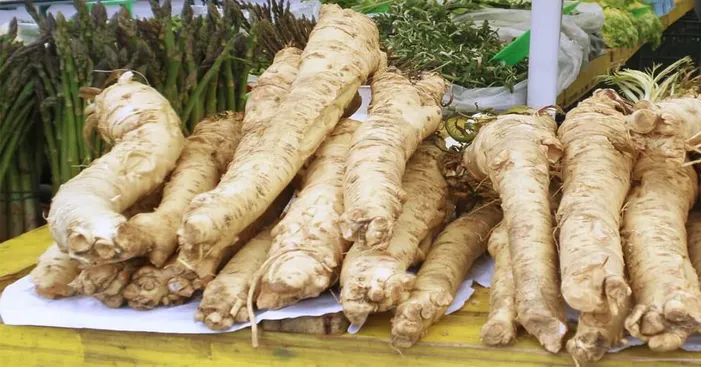
Since ancient times, horseradish has been appreciated for its virtues.
According to the legend, the oracle of Delphi would have declared to Apollo that horseradish was worth gold.
The Egyptians knew horseradish as early as 1500 BC and used it as a remedy and a condiment.
In the Middle Ages, the root and leaves were used to treat various ailments.
The root was also used to season meat in Germany, Scandinavia, and Great Britain.
Around 1590, Settlers brought horseradish to North America where the term horseradish appeared for the first time in English.
The root is shaped and sized like the genitals of a horse but despite its name, this plant is harmful to horses.
Horseradish varieties:

Atlant:
Atlant is the most common variety of horseradish in Poland.
Although it was raised by selection methods, it is ideal for growing in the middle way.
This variety belongs to the mid-season varieties and is quite resistant to extreme temperatures and lack of watering.
The flower of this horseradish is white and very fragrant.
As for the root of this variety, it is uniform, milky white, with a dense pulp that keeps perfectly in winter and it can be planted in any soil.
Katran:
This variety of horseradish is easy to grow and is distinguished by its high yield and resistance to low temperatures.
The roots and leaves of this plant are edible.
In the first year of cultivation, the roots are quite thin, but in the second year, their weight can reach one kilogram.
The leaves are large and light.
Katran is a popular variety of horseradish and one of the most grown by home gardeners and professionals.
Accord is one of the popular varieties of Katran. It is often planted in vegetable gardens.
Wasabi:
Wasabi is a Japanese herb that is well known in Russia due to the popularity of Japanese cuisine.
Generally, wasabi is not different from other cultivated plant varieties, except that it has a characteristic green color.
In areas with frequent temperature changes, it is recommended to grow this variety of horseradish in greenhouse conditions to prevent the crop from dying.
If you are growing this variety in the field, it is recommended to place a garden bed near a reservoir or small waterfall to create optimal moisture for the crop.
If this is not possible, it is necessary to monitor air and soil moisture with special care.
Wasabi needs sulfur for normal growth and development.
Most people are familiar with wasabi horseradish mustard, which is served with bread rolls and sushi.
Horseradish root nutritional values and health benefits:

Nutritional values:
Horseradish contains sinigrin, a glucosinolate that gives it its pungent taste and characteristic odor.
This compound converts to mustard oil (allyl isothiocyanate) when plant cells are damaged by chewing or grinding.
Mustard oil has antibacterial properties and may destroy pre-cancerous cells13.
It is also a good source of fiber, which aids digestion, prevents constipation, and boosts metabolism.
This vegetable provides the body with essential amino acids that cannot be synthesized on its own.
In addition, it contains more vitamin C than citrus fruits, which are known for their content of this nutrient.
It also contains vitamin E, a natural antioxidant, as well as the entire group of B vitamins and vitamin A.
Horseradish provides manganese, copper, iron, calcium, sodium, potassium, and phosphorus, all of which are essential for the proper functioning of the body.
The leaves are also rich in carotene, a precursor of vitamin A.
Furthermore, horseradish root has a low caloric value and stimulates the appetite, which helps to improve all metabolic processes.
Health benefits:

For women:
- This vegetable stimulates metabolism, regulates intestinal transit, and helps to lose weight.
It also helps to firm the skin and fight cellulite. - Horseradish powder can be applied to the skin.
It can be incorporated into masks and wraps to slim the stomach, thighs, and arms. - To reduce the desire to eat, you can prepare an infusion of horseradish and honey.
Drink it one hour after the main meal, once a day.
For kids:
- When it comes to feeding toddlers, the valuable properties of a vegetable should not be overlooked.
This begetable often irritate the mucous membranes of the stomach and intestines, disrupt digestion and make it difficult to digest food. - Horseradish should indeed be part of the baby’s diet later on.
But it is necessary to wait until he is at least two years old, or even three.
The main condition is that the child does not have kidney, gastric, intestinal, or liver problems, or individual allergies or intolerances. - Children are not often treated with pure horseradish.
This spice is added to vitamin complexes (salads).
In general, these dishes consist of boiled carrots and beets, green onions, and horseradish.
All this is seasoned with fresh cream or olive oil/sunflower. - For horseradish to be beneficial for children, you need to prepare it yourself and not buy powder forms.
These product is invaluable for the child. - Thus, regular consumption after the approval of a pediatrician allows the prevention of dystrophy.
In addition, horseradish will reduce the risk of developing anemia, and kill helminths and other parasitic worms.
Amino acids and vitamins will strengthen the body of children during the spread of viruses.
For men:
- Horseradish is a natural libido booster, especially thanks to its root.
This vegetable increases the sexual desire of men and makes them attractive to women. - Horseradish is often used as a natural remedy to strengthen virility and fight impotence.
For this purpose, it is advisable to consume the root in brine or an infusion made from freshly peeled horseradish. - Many men suffer from premature baldness.
To prevent and treat this problem, the juice of a vegetable mixed with water can be applied to the scalp. - The plant is very useful for treating urological diseases.
Its diuretic effect relieves pain during urination and prevents the formation of stones. - Some men are affected by inflammation of the sciatic nerve.
This problem is due to a sedentary lifestyle. Horseradish massage helps to eliminate congestion and reduce pain. - Horseradish has the property to increase the production of red blood cells.
This quality is appreciated by all men, as they are more exposed than women to blood vessels, heart, and joint disorders.
Other health benefits:
- Reducing the fermentation of food in the intestine;
- Facilitating the expulsion of respiratory secretions;
- Improving the control of diabetes;
- Preventing the formation of urinary stones;
- Reducing gum bleeding and treating oral problems;
- Eliminating intestinal parasites (worms, etc.);
- Protecting against scurvy;
- Regulating excess water in the body.
Precautions before you consume horseradish root :

- It is important to consume the product in moderation, as excessive consumption can be harmful to health.
The plant is often used as a flavoring for various dishes. - You should also know that the product is not recommended in large quantities for people with chronic diseases.
Horseradish is not recommended in case of disorders in the functioning of the kidneys, liver, or digestive system. - It may harm people with nervousness or nervous system problems.
Horseradish is prohibited for people with tuberculosis at any time. - The plant is strictly forbidden to people who suffer from asthma or hypothyroidism.
It is best to avoid using it during heavy menstruation.
The product can increase the risks of hemorrhage. - If you are taking medication, you should ask your doctor’s advice before consuming the vegetable.
Otherwise, some components could be incompatible and cause an unexpected reaction in the body. - An overconsumption of horseradish root, can raise your blood pressure and cause serious bleeding.
Horseradish also irritates the mucous membrane of the internal organs and can cause skin rashes.
Using horseradish root:
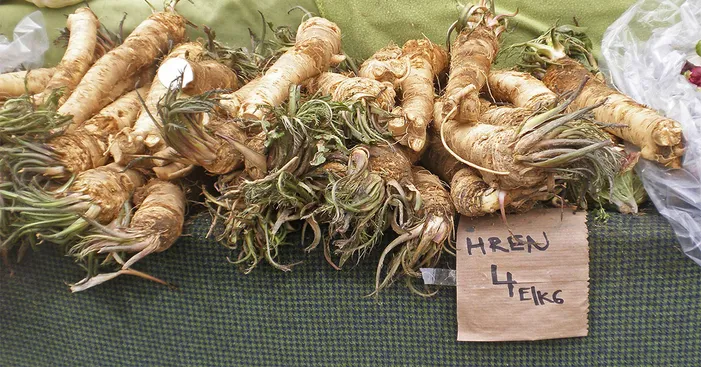
Horseradish can be used to flavor mashed potatoes, salad dressings, and soups, or as a condiment for salads and steamed vegetables.
Also, it has a strong flavor that works well with tangy flavors like pickled beets or a cold lemon sauce.
In addition, horseradish root lends itself to raw meat dishes.
For example, you can make salmon tartar with horseradish, lemon, and apple.
Crispy veal cutlets with horseradish:
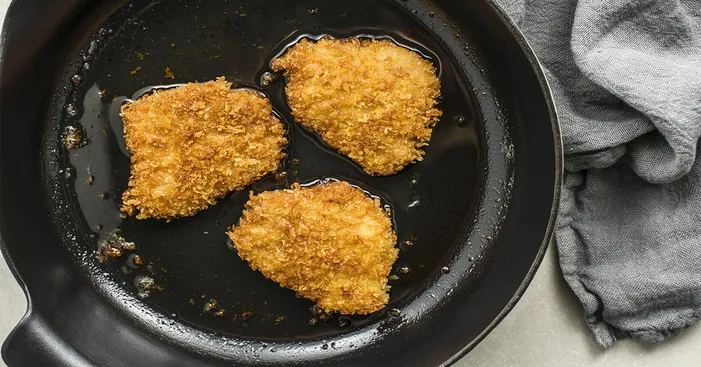
Ingredients:
- 4 slices of veal tenderloin, typically from the inner thighs
- 4 tablespoons of wheat flour.
- 2 eggs.
- 3 tablespoons of breadcrumbs.
- 2 tablespoons of butter.
- olive oil.
- Roasted potatoes.
Preparation:
- Dab the veal tenderloin slices with paper towels and flatten them slightly (perhaps the butcher has already done this for you).
- Pour the wheat flour, eggs, and breadcrumbs into three soup plates and beat the eggs with a little salt.
- Dip the meat in the flour, eggs, and breadcrumbs, making sure it is well coated on all sides, and place it on another plate. This is important to get the breading just right.
- Let your breaded cutlets rest for 10 minutes before cooking.
- Heat a skillet over medium heat and add the butter and oil.
- You must cook a schnitzel on high heat (7-8 on a scale of 1-9), otherwise, they will not be crispy but will be bathed in fat and that’s not very good, so turn the heat up high and only turn them once!
- Cook the schnitzels for 2-3 minutes on each side no more, otherwise the meat will become dry and bland, so only cook one schnitzel at a time, otherwise, you risk cooling the pan.
- If you need to cook more, you can keep them warm in the oven at 60 degrees without them drying out.
- Serve the cutlets with a few slices of organic lemon on top and serve with roasted potatoes and peas. Or with a boy, as seen below.
Parisian steak with horseradish:
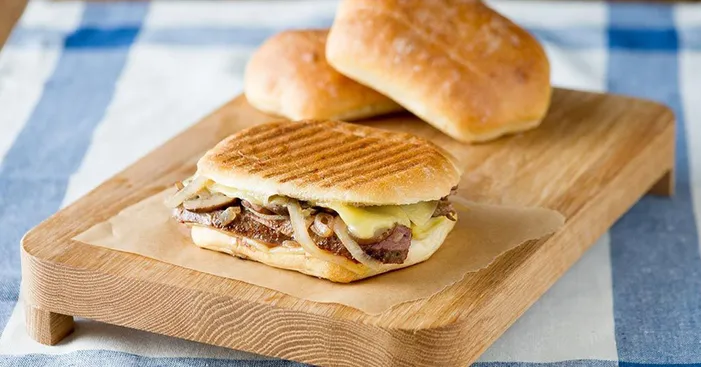
Ingredients:
- 250 grams of ground beef.
- Butter for frying.
- 1 slice of French bread.
- Pickled beets.
- Pickles.
- onion.
- caper.
- horseradish.
- 1 egg.
Preparation:
- A large beef steak is seared in hot butter in a skillet.
- It takes about three minutes to cook each side. Salt and pepper to taste.
- A slice of country bread is then toasted in the same pan with butter on both sides.
- The steak is served on crusty and buttered bread.
- Chopped and marinated beets, pickles, and chopped onions are served on the side.
- A good burger steak is also served with grated horseradish, and to top it all off, egg yolk is placed in an onion ring to prevent it from dripping.
- If you’re not a fan of raw egg yolk, you can substitute it with a fried egg. It’s delicious too.
Storing horseradish root:
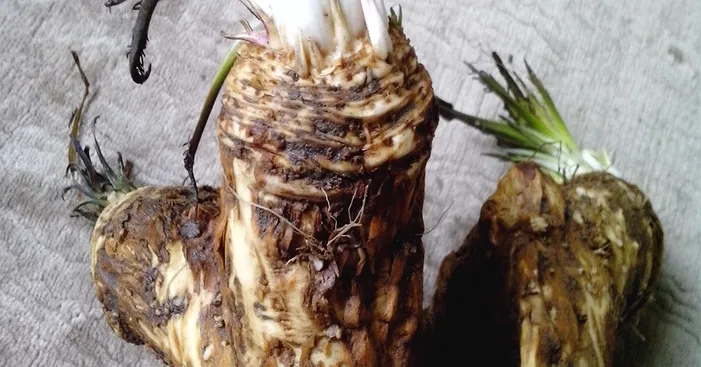
Horseradish loses its flavor quickly once grated.
It is best to use it immediately or add it at the end of cooking, without simmering.
You can store fresh horseradish in an airtight container in the refrigerator for a few weeks.
However, it is best to freeze it and grate it straight from the freezer.
Frozen horseradish roots can be stored in the freezer for up to a year without losing their beneficial properties and taste.
Here’s how to freeze them:
- The horseradish roots are first cleaned with the skin, washed with cold water, and dried with paper towels.
- Then they are twisted in a meat grinder.
The ground raw materials are then arranged in portioned bags and quickly frozen. - In the same way, it is possible to freeze and cut the root into pieces.
